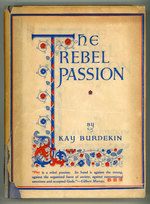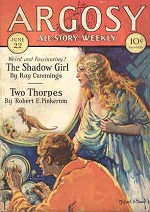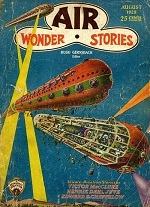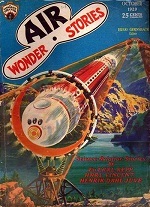|  
 | | | |  | | The Rebel Passion
by Katharine Burdekin (as by Kay Burdekin)
First publication: 1929

Twelfth-century monk Giraldus of Glastonbury, a man with the soul of a woman, is taken by a Child of God to see the epochs of time from the emergence of man from primeval slime through 21st-century Britain where women have equal rights, unfit people are sterilized, and dark-skinned people have been relocated out of Europe. By the fourth millennium, this muddled book shows an all-Christian Europe of happy people. | |
| | | | |

 | | | |  Most of my early listings without quotations are based on reviews in Bleiler’s Science Fiction: The Early Years. Most of my early listings without quotations are based on reviews in Bleiler’s Science Fiction: The Early Years. | | The Time-Journey of Dr. Barton:
An Engineering and Sociological Forecast Based on Prestne Possibilities
by John Lawrence Hodgson
First publication: 1929

Dr. Barton travels to the year 3927 where the world’s population has grown to an unimaginable eight billion, but fear not! The utopian society has elimated waste from poor economic systems of the past, and all inhabitants now work (by choice) for but one month per year. | |
| | | | |

 
 
 | | | |  | | “The Shadow Girl”
by Ray Cummings
First publication: Argosy, 22 Jun - 13 Jul 1929

In the year 7012 A.D., scientist Poul and his beautiful (shadowy) granddaughter Lea construct a tall tower that can travel throughout time in the area that is presently Central Park in New York City, but an evil mimic creates his own tower from which he conducts time raids (most often involving Lea), and counter-raids ensue.

Lea is but one of the prolific Cummings’s many girls! You can also have the Girl in the Golden Atom, the Sea Girl, the Snow Girl, the Gadget Girl, the Thought Girl, the Girl from Infinite Smallness, and the Onslaught of the Druid Girls. No vision this! Reality! Empty space, two moments ago. Then a phantom, a moment ago. But a real tower, now! Solid. As real, as existent—now—as these rocks, these trees! No vision this! Reality! Empty space, two moments ago. Then a phantom, a moment ago. But a real tower, now! Solid. As real, as existent—now—as these rocks, these trees! 
| |
| | | | |

 
 
 | | | | 



| | Stories of Addison, Time Traveler
by Henrik Dahl Juve
First story: Air Wonder Stories, Aug 1929

 After wandering around the fourth and fifth dimensions for some time, 20th century scientist Theodore A. Addison rematerializes himself in a 28th century filled with many amazing inventions and a war between the west and the Occidentals. In his review of the story, Robert Jennings notes that “Every few paragraphs in the story everything stops as the protagonist inquires about the science behind some future marvel.” In all, three stories were set in this world, although only the first two (“The Silent Destroyer” and “The Sky Maniac”) featured Addison; the third (“The Vanishing Fleet”), according to Everett F. Bleiler, was an adventure set against the same background. After wandering around the fourth and fifth dimensions for some time, 20th century scientist Theodore A. Addison rematerializes himself in a 28th century filled with many amazing inventions and a war between the west and the Occidentals. In his review of the story, Robert Jennings notes that “Every few paragraphs in the story everything stops as the protagonist inquires about the science behind some future marvel.” In all, three stories were set in this world, although only the first two (“The Silent Destroyer” and “The Sky Maniac”) featured Addison; the third (“The Vanishing Fleet”), according to Everett F. Bleiler, was an adventure set against the same background.

Apparently, Juve and his wife lived just down the road from me (in Moscow, ID) while I was bean’ edicated in Pullman, but I didn’t know of him then. As they watched, paralyzed, the building and air barge fell apart and hurtled toward the earth. The entire train had been split from end to end. The attacker now swung back and the then darted away. As they watched, paralyzed, the building and air barge fell apart and hurtled toward the earth. The entire train had been split from end to end. The attacker now swung back and the then darted away. 

—The Sky Maniac
| |
| | | | |

 
No Time Travel. Move along. |
“The Seventh Generation” by Harl Vincent, Amazing Stories Quarterly, Winter 1929 [just a dream ]

| |     |